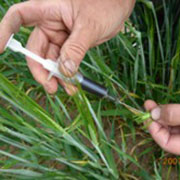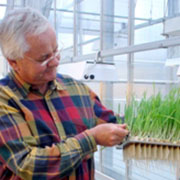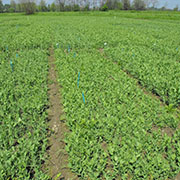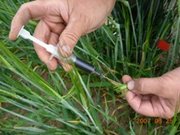COBRA



More about the project
Main results and conclusions
At the mid-term point COBRA has made significant progress in achieving the projects five main objectives. Already two scientific publications have been published from work conducted during the project and a further five papers have been submitted. Many of the experiments planned for COBRA are field studies and therefore the results of these will only become available later in the lifespan of the project after multiple field seasons have been completed. Currently, trials of spring crops have had two full field seasons, whereas autumn sown crops have only had one, so many of the key results at this point are biased towards the former. Some of the key results and conclusions from the project to-date are listed below:
- 800 recombinant inbred lines of winter wheat, representing populations containing 6 different sources of dwarf bunt resistance, have been identified.
- Bunt resistance studies in winter wheat populations have found no decrease in disease infection levels after selection over two seasons, suggesting that it is possible that selection pressures may be working to both increase bunt resistance in wheat and at the same time to increase the virulence of bunt.
- Studies of combinations of abiotic stresses (Heat, CO2,O3) on a large number of spring barley accessions have indicated that environmental stability is not only a result of diversity, but also has to do with the presence of specific genes. Furthermore, genome-wide association analysis of production and stability traits in accessions of spring barley has identified 60 marker-trait associations from 44 SNP markers covering 25 LD blocks. These experiments have demonstrated that genome-wide association analysis is a suitable method to identify markers and chromosome regions to be targeted in breeding for development of climate resilient cultivars. This work has generated multiple publications.
- Studies of spring wheat to investigate the weed competitive abilities of populations, mixtures and homogeneous cultivars have so far demonstrated that seed weight has a large influence on competitive ability; however genetics also has an influence.
- Experiments using a single seed protein sorter based on NIRS have demonstrated that it is possible to increase or decrease the protein content and Zeleny value in bi-parental spring wheat populations by single seed sorting of the seed before sowing. This may therefore be a viable way to increase protein content in these populations in order to develop high quality baking wheat populations.
- Investigations into spectrometric measurements, colour images and thermal images of a barley field experiment with different degrees of drought stress in a rain-out-shelter has demonstrated the potential of simple methods of image analysis for the assessment of Ground cover, Biomass, LAI, Senescence, Leaf Chlorophyll content and grain yield. A publication has been submitted on this research.
- Trans-national case studies are underway to investigate a number of subjects, including: (1) Resources and bottlenecks within the organic soybean production in Italy; (2) Speciality food barley (Italy and Austria); (3) Study on status quo analysis of organic wheat for bread and pasta for local bakeries and processors, in relation to organic wheat seed production and breeding (Slovenia); (4) Case study on problems related to maintaining seed quality and quality traits of common beans (Phaseolus vulgaris) (Slovenia); (5) Case study on weed competitiveness in spring barley (Denmark); (6) Case study on baking quality in wheat (Denmark); (7) Issues surrounding organic seed derogations and the import of organic feed from outside the EU (UK); (8)Possibilities to organise a system for organic variety testing in Turkey; (9) Two stakeholder workshops have been held with further workshops planned for the second period of the project.
Since the start of the project communication between partners that otherwise would not have occurred has led to the development of novel experiments within the project (particularly with respect to the assessment of CCPs ability to cope with climate change). Further, developments in COBRA can be monitored on the project website, which acts as a portal for the communication of the project to the wider stakeholder community.
COBRA
41 partners across 18 European countries.
Coordinator:
Principal Researcher in Crops and Agroforestry Robbie Girling, Organic Research Centre, Elm Farm, Hamstead Marshall, Newbury, Berkshire, United Kingdom
Project stakeholders
The target groups are the same both within project partner countries and those countries outside of COBRA. They include farmers, seed producers, crop breeders, processors, traders & consumers, policy makers and society as a whole.
Although COBRA focuses on organic plant breeding in the EU its findings will have relevance to the wider agricultural sector both within the EU and internationally.

